SQL Server Integration Services is referred to as SSIS. It is a component of the potent database management system Microsoft SQL Server. Data handling is one of its main uses. SSIS, however, is about ensuring that data moves seamlessly from one location to another, not just storing it. It is a powerful part of Microsoft SQL Server that is made especially to handle difficult data transformation and integration jobs. Fundamentally, SSIS is a framework for developing enterprise-level data loading, cleansing, and movement solutions. It is an improved version of the outdated data transformation tool that came with SQL Server, called DTS (Data Transformation Services).
What toolbox is included in SQL Server Integration Services (SSIS)?
The toolbox for SQL Server Integration Services (SSIS) is similar to the one we use for home repairs. Rather than being stocked with hammers and screwdrivers, it is full with data-related equipment. It's all there in our SQL Server Integration Services (SSIS) software, ready to assist us with tasks like obtaining data from several sources, transforming it, and moving it to the appropriate locations inside our SQL Server databases.
The SQL Server Integration Services (SSIS) toolbox contains tools
There is always at least one control flow in a package. The steps in our SQL Server Integration Services package are organized in a more logical order thanks to the control flow. Step by step, our data integration process is made seamless by the Control Flow activities, which range from controlling file operations and FTP transfers to running scripts and SQL commands.
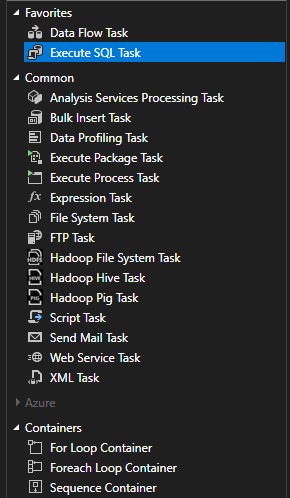
SQL Server Integration Services offers three distinct types of control flow elements:
- Containers: These elements establish organizational structures within packages. Some of the containers are For Loop Container, Foreach Loop Container, and Sequence Container. Loop containers are used to show the repetition of some tasks and sequence containers are used to show the sequence of execution of some tasks.
- Tasks: These elements provide specific functionalities to the workflow. We can also write custom tasks using a programming language such as Visual Basic, or C#. Some of the tasks are Data Flow Tasks, SQL Server Tasks, Data Profiling Tasks, Expression Tasks, FTP Tasks, Script Tasks, XML Tasks, etc.
- Precedence Constraints: These elements interlink the executables, containers, and tasks, establishing a sequential control flow. For example, in the below image, at first Data Flow Task will be executed, and then the tasks inside the Sequence Container will execute similarly.
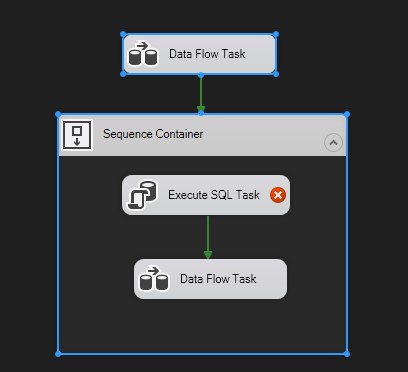
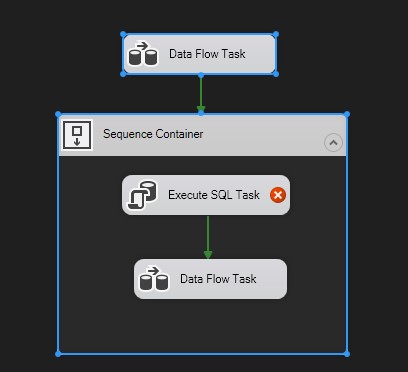
In the above image, we have a control flow that has one sequence container and three tasks. One task is defined at the package level, and the other two are defined at the container level.
Data Flow
Data Flow provides the tools that we use to move and change our data. We can use them to get data from different places like databases and files, and then change it in various ways, like sorting or filtering.
SQL Server Integration Services provides three distinct types of data flow components: sources, transformations, and destinations.
- Source Assistant: Sources extract data from data stores such as tables and views in relational databases, files, and Analysis Services databases.
- Transformation: Transformations perform various transformation tasks such as sorting, filtering, and aggregation, these components help us to convert our data into the desired form. We can also modify, summarize, and clean data.
- Destination Assistant: Destinations load data into data stores or create in-memory datasets.

In the above image, inside a group, we have an OLE DB Source and OLE DB Destination which are linked.
Variables and Parameters
Variables and parameters are dynamic elements that allow us to store values, expressions, and configurations that can be passed between tasks and components at runtime. These can be used to include in-memory lookup tables, to update properties of the package element, binding expressions, etc.
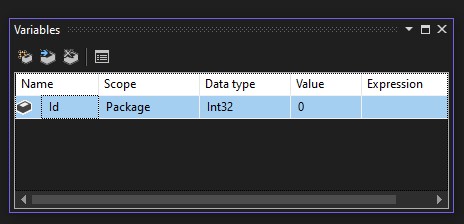
In the above image, we have a window named variable, in which, we have Name, Scope, Data type, Value, Expression, etc that we can set according to our requirement.
Event Handlers
Event Handlers serve as designated areas to handle and respond to specific events during the execution of the package. These event handlers enable the package to react dynamically to events such as task completion, errors, warnings, or custom events, enhancing its robustness and flexibility. For example, an OnError event is raised when an error occurs. We can create custom event handlers for these events to extend package functionality and make packages easier to manage at run time.
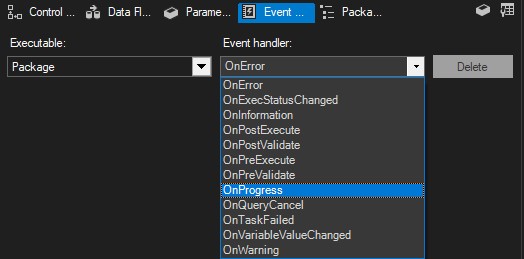
In the above image, we have different event handlers that we can use in our package to handle responses.
Package Explorer
The Package Explorer provides a visual representation of the package's structure. This displays the contents of the package in a tree view. As shown in the below image, we have Packages, Connection Managers, Log Providers, Executables, etc. The Package Explorer offers a convenient way to navigate and manage the components of the SSIS package, facilitating efficient development and troubleshooting processes.

Connection Managers
Connection Manager is responsible for managing connections to data sources and destinations within the package. These managers provide the functionality to establish and configure the connections to various data repositories, including databases, files, and cloud-based services. By centralizing connection settings, Connection Managers streamline the development process and enhance package portability and maintainability.
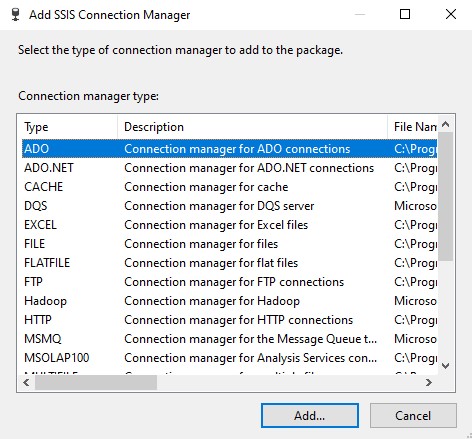
In the above image, we have the option to select the type of connection manager we want to add to the packages. Here, we have different options available like ADO, ADO.NET, EXCEL, FTP, FLATFILE, ODBC, OLE DB, etc.
HostForLIFE.eu SQL Server 2022 Hosting
HostForLIFE.eu is European Windows Hosting Provider which focuses on Windows Platform only. We deliver on-demand hosting solutions including Shared hosting, Reseller Hosting, Cloud Hosting, Dedicated Servers, and IT as a Service for companies of all sizes.
